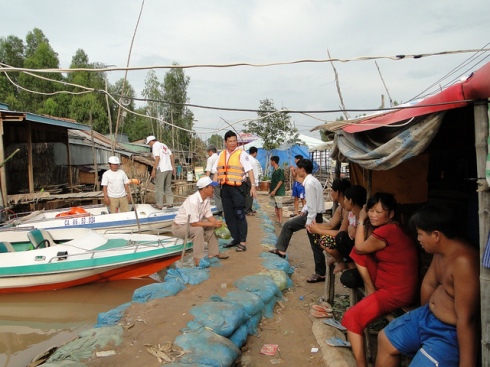
By PISA Program Assistant, Dr. Miriam Grinberg
As one of the fastest-growing markets in the world, Vietnam – with a growth rate of about 7 percent this past year – has witnessed remarkable improvements in its total gross domestic product (GDP), industrial output, and per capita income (from $260 in 1995 to $1685 in 2015) in the last few decades. Moreover, where Vietnam had previously been a net importer of rice, it is now the second largest exporter in the world after Thailand, with two-thirds of its rural labor employed in rice production.
These rice-growing areas, however, lie mostly within the Mekong River delta – a region which has become increasingly vulnerable to the effects of climate change. According to a 2011 World Bank report, the country has generally seen an increase in higher-intensity typhoons, floods, and sea levels. Sea level rise (SLR) in particular is the result of two processes: thermal expansion (through the absorption of greenhouse gases by the ocean, causing its volume and height to expand relative to coastal areas) and additional water from melting glaciers, icecaps, and permafrost. Globally, the rate of SLR has increased to 0.12 inches per year, with scientists estimating that if nothing is done to drastically decrease carbon emissions, the global average sea level could rise another 23 inches by 2100.
Unlike other climate change-related events, however, SLR is slow to start, demanding long-term planning in order to combat its effects. These include:
- Increased flooding. Up to 60% of the Mekong Delta may become very vulnerable to extreme flooding that will further erode riverbanks and beaches if SLR increases to 17.7 inches above 1997 levels.
- Forced migration and relocation. This erosion also cuts into urban zones, where an estimated 34% of Vietnamese live. Up to 1/4 of Ho Chi Minh City’s land area, for example, may be endangered by rising floodwaters, and Vietnam is among the most threatened countries by SLR in terms of the percentage of the population affected.
- Loss of arable land for agri/aquaculture. SLR has already been shown to be negatively affecting the livelihoods of millions of farmers through the reduction of available freshwater due to increased salinity levels. This added salinity (and the bacteria it carries) has led not only to significant losses in rice production and shrimp farming throughout the Delta, but has also raised concerns about the quality of the public water supply in coastal cities such as Hanoi.
- Economic costs. With nearly 78% of the Delta’s land area utilized for rice production, increased flooding could lead to annual losses of more than $17 billion.

In order to address the impacts of SLR and climate change more generally, the Vietnamese government has taken several steps already, including: the adoption of a National Target Program to Respond to Climate Change; the development of a Scientific and Technological Program on Climate Change; raising public awareness of climate change; and undertaking regular vulnerability assessments and integrating climate change into its policy strategies and programs across various ministries.
Their approach to the problem has not, however, been without criticism. In particular, the government’s construction and reinforcement of thousands of miles of dikes and dams along the Delta to curb SLR could potentially lead to an increased volume of industrial pollution being “trapped” in these barriers, as well as increase land erosion. Moreover, while the government has been providing rice farmers with additional protections, it is unclear how sustainable this support is given the future impacts of SLR. Finally, as the World Resources Institute notes, “the importance of rural life and staying on long-held family land cannot be underestimated” in Vietnam; nonetheless, there is increasingly less time to accommodate these “entrenched patterns of society” when considering the irreversible impact of climate change on the country and wider region.



2 Responses to “Climate Change and Sea Level Rise in Asia: Vietnam”